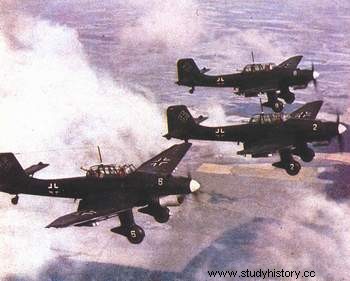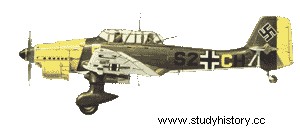
Rightly or wrongly, the Junkers Ju 87 has become synonymous with blitzkrieg, under its pseudonym “Stuka”, an abbreviation of the German designation Sturzkampfflugzeug which means dive bomber. And the sinister fame of the Stuka has been such that much of the legend now attaches to the plane itself, to the point of veiling its true history. For example, this aircraft was said to have been bulky to the point of being unmissable because it was relatively easy for Allied fighters to shoot down. But this is not surprising, if we remember that the Stuka was never a fighter plane but a large single-engine bomber. The defect suggested by the qualifier "cumbersome" does not therefore directly relate to the aircraft, which was always manageable, light and capable of performing all the tricks, but to the doctrine of use of the aircraft that the command sent on objectives well protected by an effective hunt, without escort of any kind.
The Ju 87 is the direct result of a visit made by Ernst Udet to the United States, where he had the opportunity to attend some very instructive dive bombing demonstrations as to the results. Designed by Hermann Pohlmann, the Ju 87 first flew in 1935. The initial prototype differed radically from its successors in several respects:it had a Rolls-Royce Kestrel engine, a twin-tail stabilizer at the end of the fixed plane, and more than a fairing, a "pants" landing gear. The Ju 87 V2 received a single fin.
The aircraft almost ended its career prematurely in June 1936, when the technical management of the RML decided to stop its development. The course of the Second World War might have been changed if Ernst Udet had not taken charge of this service, the day after this
order had been issued, for the cancel immediately. Work resumed quickly. The Ju 87 V3, which was already flying at that time, was powered by the Junkers Jumo which was to equip the entire series. By mid-1936, the main features of the Ju 87 had been fixed, except for the final undercarriage fairing, which was further modified later.
When the Jumo 211 engine, more powerful, was available in 1937, Junkers seized the opportunity to improve his plane by mounting this engine instead of the Jumo 210. This modification led to a significant alteration of the lines of the cell and the fin, to the point that the front , the canopy of the cockpit and the rear of the fuselage seemed less aerodynamic than on the Ju 87 A. The undercarriage was also reviewed, and streamlined legs replaced the "pants" of wheels previously connected to the fuselage by tie rods. This resulted in simplified assembly and maintenance. Towards the end of 1938, a few Ju 87 B-1s were sent to Spain.
In the years before the war, Germany had begun construction of an aircraft carrier, the Graf Zeppelin, for which the aircraft endowment was to include a fleet of navalized Ju 87s. These Ju 87 C were extrapolated from the 87 B for this purpose by adding catapult hooks, flotation systems, folding wings and a releasable landing gear. Only a few pre-production aircraft were born before the abandonment of the "Graf Zeppelin" project. A contemporary and parallel production to the 87-B series was the 87-R series which, very similar, had reduced offensive power and increased fuel capacity for distant attacks from ships.
The next type was the Ju 87 D, designed to accommodate the latest Jumo 211 engine, the 211 J:the contours of the nose were simplified and the canopy very effectively profiled. The fixed armament did not exceed two 7.92 mm machine guns, but the shooter now had two weapons of the same caliber instead of only one before. The transportable bomb load amounted to almost 1,800 kg. The Ju 87 D-1 entered service in the spring of 1942, and this series was built in very many copies and under various designations corresponding to minor differences due to the special equipment that was fitted. Thus, the Ju 87 D-7 intended for night attacks received a pair of 20 mm cannons instead of the front machine guns. The Ju 87 F and 187 were modernized versions under consideration, intended to rejuvenate the basic design of the aircraft, but neither were built. Alongside the Ju 87 D, Junkers produced the Ju 87 H, a dual-cockpit trainer designed to train bomber and fighter pilots to fly the Stuka. The last version of this aircraft was the Ju 87 G series of which only the Ju 87 G-1 was built. Intended for attacking armored vehicles, it received two 37 mm BK 37 guns suspended under the wings by “pods” with their magazine. This weapon proved to be formidable, especially in the hands of Stuka specialists such as ace Hans Ulrich Rudel. Production of the Ju 87 ceased in the summer of 1944, after 5,700 had been built.
The Stuka was a very effective weapon when used against infantry in open terrain and in the absence of any air protection. These conditions were to be those of the campaigns against Poland, Belgium, Holland and France in 1939-40 and against Russia in. 1941-43. In the presence of enemy hunting, the Stuka was no more than an often deadly trap for its crews. Anyway it was, on the German side, an excellent combat aircraft.
dates
commissioning date :1938
date of end of use :1945
Nationalities :Germany
Manufacturer :Junker
Users :Germany Italy Spain

Categories :Light bomber, dive bomber, support aircraft

Technical and Performance Data
Wingspan :13.80m
Length :11.10m
Height :4m
Weight :2762kg
Maximum Weight :4336kg
Area :31.90m/2
Range :790km without load; 595km with 500kg of bombs
Maximum Speed :385km/h at 4000m and 340 km/h at sea level
Ascent Speed :3700m in 12 minutes
Practical ceiling :8000m
Cruising speed :330km/h at 3700m

Motorisation (engines or reactors) - 1 Junker Jumo 211Da with 12 cylinders in V, liquid-cooled giving 1200 hp at take-off and 1000 hp at 1500m
Armaments :
 defensive:two 7.62 machine guns in the wings and one adjustable in the rear cockpit
defensive:two 7.62 machine guns in the wings and one adjustable in the rear cockpit
 offensive:1 bomb of 500kg and 4 of 50kg 2 cannons of 37mm BK37 suspended under the wings for the tank killers version Ju87g
offensive:1 bomb of 500kg and 4 of 50kg 2 cannons of 37mm BK37 suspended under the wings for the tank killers version Ju87g
